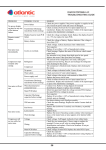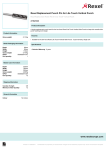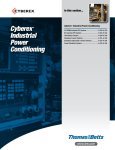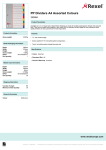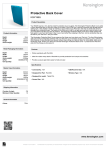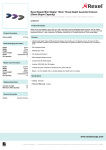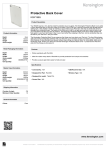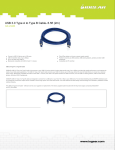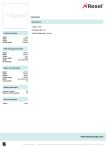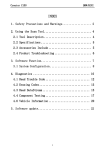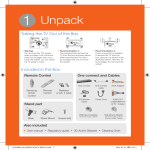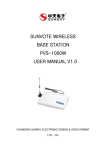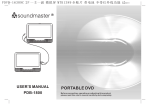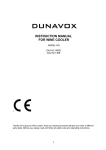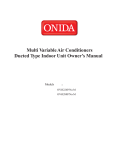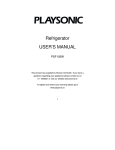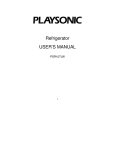Download - Changhong
Transcript
VERTICAL FREEZER USER’S MANUAL FSF209R02W Please read the manual carefully before operation and keep it for reference. This manual is only for reference, please comply with actual appliance you selected. manufacturer hold the authority to redesign or modify its products without notice. NAMES OF THE PARTS 1 2 3 4 5 6 WARNING: Top cover Display Block Freezer Flap Middle Drawer Low Drawer Adjustable feet Never touch the interior of the Freezer or frozen foods in the compartment with wet hands as this could result in frost bite. 1 IMPORTANT SAFETY INSTRUCTIONS WARNING To reduce the risk of fire, electrical shock, or injury when using your refrigerator, follow these basic precautions: Read all instructions before using the refrigerator. DANGER or WARNING: Risk of child entrapment. To avoid the possibility of child entrapment, please take the following precautions before throwing out the refrigerator. - Remove all doors from the unit. - Leave the shelves in place so that children may not easily climb inside. Never allow children to operate, play with, or crawl inside the refrigerator. This appliance is not intended for use by persons (including children) with reduced physical, sensory or mental capabilities, or lack of experience and knowledge, unless they have been given supervision or instruction concerning use of the appliance by a person responsible for their safety. Children should be supervised to ensure that they do not play with the appliance. Never clean refrigerator parts with flammable fluids. The fumes can create a fire hazard or explosion. This appliance is intended to be used in household and similar applications such as: - staff areas in shops, offices and other working environments; - farm houses and by clients in hotels, motels and other residential type environments; - bed and breakfast type environments; - catering and similar non-retail applications Do not store or use gasoline or any other flammable vapors and liquids in the vicinity of this or any other refrigerator. The fumes can create a fire hazard or an explosion. If the supply cord is damaged, it must be replaced by the manufacturer, its service agent or similarly qualified persons in order to avoid a hazard. - Please read and save these instructions - WARNNING 1. This appliance is not intended for use by persons, (including children) with reduced physical, sensory or mental capabilities, or lack of experience and knowledge, unless they have been given supervision or instruction concerning use of the appliance by a person responsible for their safety. 2. Children should be supervised to ensure that they do not play with the appliance. 3. Keep ventilation openings, in the appliance enclosure or in the built-in structure, clear of obstruction. 4. Do not use mechanical devices or other means to accelerate the defrosting process, other than those recommended by the manufacturer. 5. Do not damage the refrigerant circuit. 6. Do not use electrical appliances inside the food storage compartments of the appliance, unless they are of the type recommended by the manufacturer. 7. Do not store explosive substances such as aerosol cans with a flammable propellant in the appliance. 8. This appliance is intended to be used in household and similar applications such as staff kitchen areas in shops, offices and other working environments; farm houses and by clients in hotels, motels and other residential type environments; bed and breakfast type environments; catering and similar non-retail applications. 2 R600A WARNINGS NOTE: This model uses 0.087Kg of R600A flammable refrigerant in its sealed system. The following must be observed for your safety: R600A Refrigerant Warning • This appliance contains a small quantity of R600A refrigerant which is environmentally friendly, but flammable. It does not damage the ozone layer, nor does it increase the greenhouse effect. • During transportation and installation, ensure that the tubing of the refrigerant circuit is not damaged. • Leaking refrigerant can ignite and may damage the eyes. • In the event any damage does occur, avoid exposure to open fires and any device which creates a spark. Disconnect the appliance from the mains power. • Thoroughly ventilate the room in which the appliance is located for several minutes. • Notify Customer Service for necessary action and advice. • The room for installing the appliance must be at least 1 cubic metre per 8 grams of refrigerant. The refrigerant quantity contained in this appliance is listed above in grams; it is also noted on the Rating Plate of the appliance. It is hazardous for anyone other than an Authorised Service Person to carry out servicing or repairs to this appliance. In Queensland the authorized person must hold a Gas Work Authorisation for hydrocarbon refrigerants, before carrying out servicing or repairs which involve the removal of covers. INSTALLATION INSTRUCTIONS Transportation and Handing When moving the unit, always hold the base, and lift carefully while keeping the unit upright. The unit should never be tilted beyond 45 degrees, placed upside down, or laid on its side, back, or front. Never hold onto the door for support while moving the unit. It may damage the hinges. Installation 1. Place the freezer on a flat, firm surface. This will help eliminate noise caused by vibration. 2. Choose a ventilated area. There should be at least 10 cm of open space along the sides, top, and back of the freezer. 3. Select a location which is away from heating sources, direct sunlight, ovens, etc. Also, the area should be dry, and free of damp, stale air. Testing 1. Clean the freezer with lukewarm water and detergent, and wipe dry. Note: Electrical components should be cleaned with a dry cloth. 2. Turn the thermostat knob to the “2” position, and plug the freezer into the wall outlet. The compressor will begin to run. 3. Check, after 30 minutes of operation, to ensure that the freezer is cold. 3 Electrical Connection WARNING Please make sure the power socket has been fitted by a qualified electrician and the ground wire has been connected properly. They all meet the standards of the Australia Electrical Standards. OPERATING YOUR REFRIGERATOR Temperature Control 1. The temperature control (thermostat knob, turned by coin) is located near the top of the unit. 2. Turning the thermostat knob adjusts the temperature of the freezer. 3. The marks on the knob represent different settings. Setting “1” is the warmest and setting “4” is the coolest. 4. The factory recommended setting is “2” for normal operating conditions. Tips and Hints 1. Fresh foods such as fish and meat can be frozen to maintain freshness, and keep the nutrients in the food. 2. Food should be wrapped in aluminum foil, or some other type of airtight packing. 3. Do not allow frozen food in freezer to touch foods just placed into freezer. It can damage the food. 4. Frozen foods from the store should be placed in the freezer promptly, so they do not thaw. 5. Never place fresh vegetables and fruits into the freezer as they can get freezer burn. Defrosting 1. When the freezer operates for a long period of time, the surface of the evaporator and the drawers may become covered with a layer of white frost. This frost will reduce the energy efficiency of the unit, and make the freezer less effective. When this frost forms, it should be promptly removed. 2. When defrosting, unplug the freezer, and remove all food from the freezer. Either allow the frost to melt naturally from the warm air in the room, or carefully use a plastic scraper. Finally, wipe away any remaining ice and water, plug the freezer in, and return the food to the freezer. CAUTION: Never use sharp tools to chip ice away. 4 Precautions: 1. The freezer should be located in a place that allows. 2. Do not sit on freezer, or place heavy objects on top of freezer. 3. Do connect your freezer to an independent power outlet. Always make sure to use a safe ground wire. The voltage should be limited within the ranges from 220V to 240V, or the main motor will be damaged. 4. After a power outage, wait 5 minutes before turning freezer on. Otherwise, the compressor may become damaged. 5. Always allow for proper air circulation to the back, sides, and top of unit. Also, make sure the packing base is removed from the bottom of the unit prior to operation. 6. Keep the power cord away from the compressor and condenser to prevent damage to the cord due to high temperatures. 7. For best energy efficiency, open the freezer infrequently. Frequent opening of the door requires extended compressor run time, which increases the energy consumption. 8. Clean freezer after each defrosts. 9. Do not touch frozen food with wet hands, as you can suffer frostbite. 10. Do not use the extended power cords. 11. Warning-Do not damage the sealed system. 12. Warning-Do not use electrical appliances inside the freezer. 13. Before disposing of this freezer at the end of its useful life, capture the refrigerant accordingly. 14. The appliance must be positioned so that the plug is accessible. 15. If the supply cord is damaged, it must be replaced by the manufacturer or its service agent or a similarly qualified person in order to avoid a hazard. CARE AND MAINTENANCE General Instructions for Care and Maintenance Once a month, clean the freezer. See below for cleaning instructions. If you wish to stop using the freezer for a long period of time, make sure you unplug the freezer from the outlet, remove all food, clean and dry the freezer, and leave the freezer door open, to eliminate any unpleasant odors. How to Clean: 1. Unplug the freezer. 2. Use water and a non-abrasive detergent. 3. Clean with a soft cloth soaked in this solution and always dry prior to resuming operation. 5 TROUBLESHOOTING GUIDE You can solve many common refrigerator problems easily, saving you the cost of a possible service call. Try the suggestions below to see if you can solve the problem before calling for service. Trouble shooting Symptom: Appliance will not work at all. Cause: The unit is not plugged into the outlet, or the plug is loose. Power is not being supplied to the outlet in the home. Symptom: Noisy operation. Cause: The freezer is not on a flat surface. The freezer is in contact with a wall or other object. NOTE: The following are normal operation. These are not indications of improper operation. 1. Refrigerant may make a gentle sound similar to running water. 2. In humid areas, some moisture may gather on the outside of the freezer. Just wipe away. 3. The compressor becomes very hot. Do not touch the compressor. 4. Heat around the door frame is normal. Any other enquiry, please call our service centre as: 1300 796 688. 6 7








